Toyota Sienna Service Manual: EVAP System
RELATED DTCS
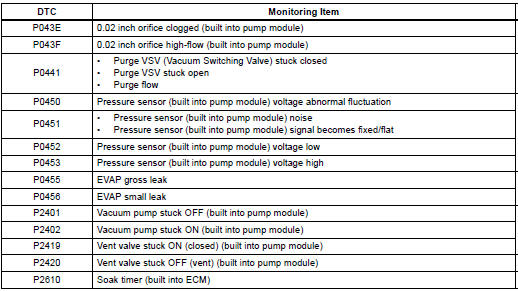
If any EVAP system DTCs are set, the malfunctioning area can be determined using the table below.
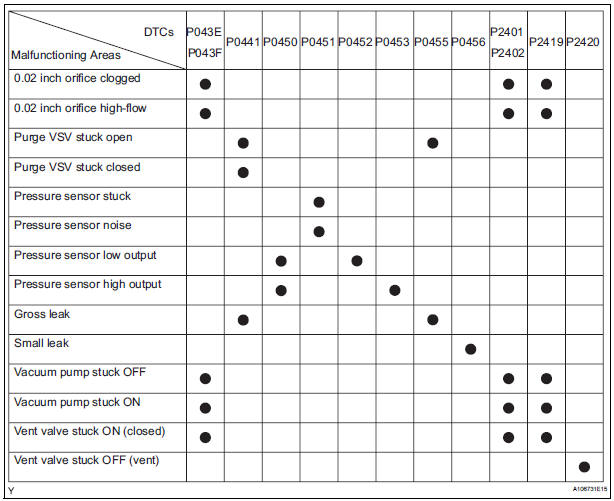
NOTICE: If the 0.02 inch reference pressure difference between the first and second checks is greater than the specification, the DTCs corresponding to the reference pressure (P043E, P043F, P0441, P0455, P0456, P2401, P2420) will be all stored.
CONFIRMATION DRIVING PATTERN
HINT: After a repair, check Monitor Status by performing the Key-Off Monitor Confirmation and Purge Flow Monitor Confirmation described below.
1. KEY-OFF MONITOR CONFIRMATION
- Preconditions The monitor will not run unless:
- The vehicle has been driven for 10 minutes or more (in a city area or on a freeway)
- The fuel tank is less than 90% full
- The altitude is less than 8000 ft (2400 m)
- The Engine Coolant Temperature (ECT) is between 4.4C and 35C (40F and 95F)
- The Intake Air Temperature (IAT) is between 4.4C and 35C (40F and 95F)
- The vehicle remains stationary (the vehicle speed is 0 mph [0 km/h])
- Monitor Conditions
- Allow the engine to idle for at least 5 minutes.
- Turn the ignition switch off and wait for 6 hours (8 or 10.5 hours).
HINT: Do not start the engine until checking MONITOR STATUS. If the engine is started, the steps described above must be repeated.
- Monitor Status
- Connect the intelligent tester to the DLC3.
- Turn the ignition switch to the ON position and turn the tester on.
- Select the following menu items: DIAGNOSIS / ENHANCED OBD II / MONITOR STATUS.
- Check the "Monitor Status" displayed on the tester.
HINT: If INCMP is displayed, the monitor is not completed. Make sure that the preconditions have been met, and perform "Monitor Conditions" again.
2. PURGE FLOW MONITOR CONFIRMATION (P0441)
HINT: Perform this monitor confirmation after the Key-Off Monitor Confirmation shows COMPL (complete).
- Preconditions
The monitor will not run unless:
- The vehicle has been driven for 10 minutes or more (in a city area or on a freeway)
- The ECT is between 4.4C and 35C (40F and 95F)
- The IAT is between 4.4C and 35C (40F and 95F)
- Monitor Conditions
- Release the pressure from the fuel tank by removing and reinstalling the fuel tank cap.
- Warm the engine up until the ECT reaches more than 75C (167F).
- Increase the engine speed to 3000 rpm once.
- Allow the engine to idle and turn the A/C ON for 1 minute.
- Monitor Status
- Turn the ignition switch off.
- Connect the intelligent tester to the DLC3.
- Turn the ignition switch to the ON position and turn the tester on.
- Select the following menu items: DIAGNOSIS / ENHANCED OBD II / MONITOR STATUS.
- Check the "Monitor Status" displayed on the tester.
HINT: If INCMP is displayed, the monitor is not completed. Make sure that the preconditions have been met, and perform "Monitor Conditions" again.
MONITOR RESULT
Refer to Checking Monitor Status for detailed information.
The test value and test limit information are described as shown in the following table. This information is included in MONITOR RESULT of the emissions-related DTC sections:
- MID (Monitor Identification Data) is assigned to each emissions-related component.
- TID (Test Identification Data) is assigned to each test value.
- Scaling is used to calculate the test value indicated on generic OBD II scan tools.
Thermostat

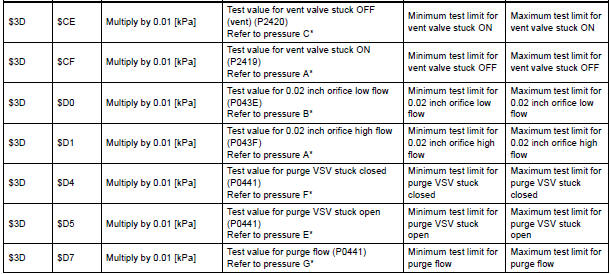
* Pressures A to G are indicated as shown in the diagram below.
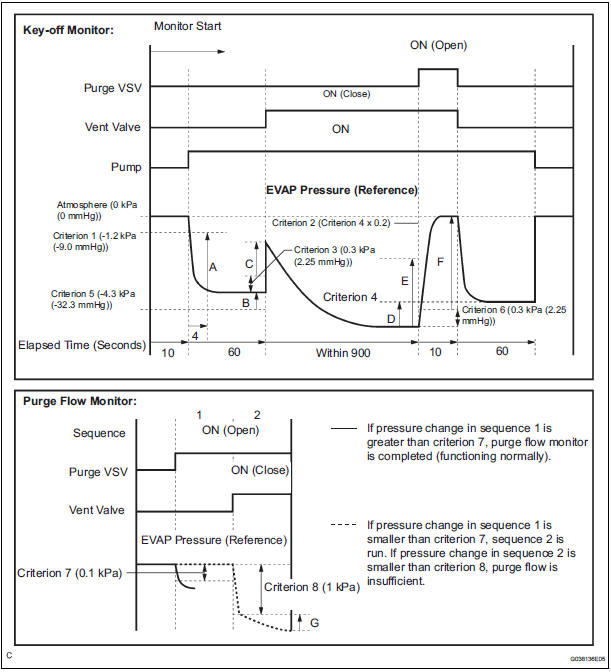
DESCRIPTION
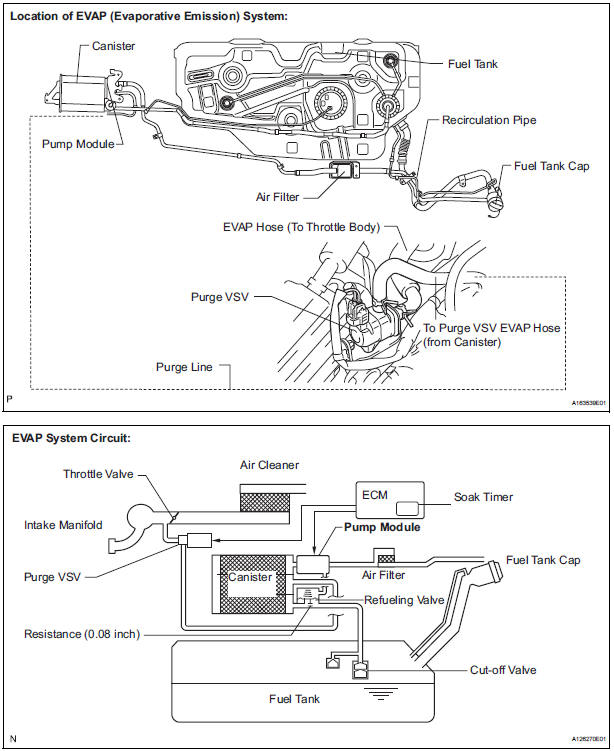
While the engine is running, if a predetermined condition (closed-loop, etc.) is met, the purge VSV is opened by the ECM and fuel vapors stored in the canister are purged to the intake manifold. The ECM changes the duty cycle ratio of the purge VSV to control purge flow volume.
The purge flow volume is also determined by the intake manifold pressure. Atmospheric pressure is allowed into the canister through the vent valve to ensure that the purge flow is maintained when negative pressure (vacuum) is applied to the canister.
The following two monitors run to confirm appropriate EVAP system operation.
1. Key-off monitor
This monitor checks for EVAP (Evaporative Emission) system leaks and pump module malfunctions.
The monitor starts 5 hours* after the ignition switch is turned off. More than 5 hours are required to allow the fuel to cool down to stabilize the Fuel Tank Pressure (FTP), thus making the EVAP system monitor more accurate.
The electric vacuum pump creates negative pressure (vacuum) in the EVAP system, and the pressure is measured. Finally, the ECM monitors for leaks from the EVAP system and malfunctions in both the pump module and purge VSV, based on the EVAP pressure.
HINT: *: If the engine coolant temperature is not below 35C (95F) 5 hours after the ignition switch is turned off, the monitor check starts 2 hours later. If it is still not below 35C (95F) 7 hours after the ignition switch is turned off, the monitor check starts 2.5 hours later.
2. Purge flow monitor
The purge flow monitor consists of the two monitors. The 1st monitor is always conducted every time and the 2nd monitor is activated if necessary.
- The 1st monitor
While the engine is running and the purge VSV (Vacuum Switching Valve) is ON (open), the ECM monitors the purge flow by measuring the EVAP pressure change. If negative pressure is not created, the ECM begins the 2nd monitor. - The 2nd monitor
The vent valve is turned OFF (open) and the EVAP pressure is then measured. If the variation in the pressure is less than 0.5 kPa (3.75 mmHg), the ECM interprets this as the purge VSV being stuck closed, and illuminates the MIL and sets DTC P0441 (2 trip detection logic).
Atmospheric pressure check: In order to ensure reliable malfunction detection, the variation between the atmospheric pressures, before and after conduction of the purge flow monitor, is measured by the ECM.
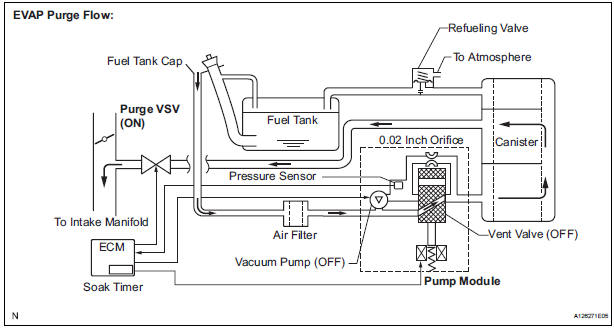
|
Component |
Operation |
| Canister | Contains activated charcoal to absorb EVAP (Evaporative Emissions) generated in fuel tank. |
| Cut-off valve | Located in fuel tank. Valve floats and closes when fuel tank is 100% full. |
| Purge VSV (Vacuum Switching Valve) | Opens or closes line between canister and intake manifold. ECM uses purge VSV to control EVAP purge flow. In order to discharge EVAP absorbed by canister to intake manifold, ECM opens purge VSV. EVAP discharge volume to intake manifold is controlled by purge VSV duty cycle ratio (current-carrying time). (Open: ON, Close: OFF) |
| Refueling valve | Controls EVAP pressure from fuel tank to canister. Valve consists of diaphragm, spring and restrictor (diameter: 0.08 inch). When fuel vapor and pressure inside fuel tank increase, valve opens. While EVAP is purged, valve closes and restrictor prevents a large amount of vacuum from affecting pressure in fuel tank. Valve is opened while refueling. When valve is open, adding fuel into fuel tank is possible. |
| Roll-over valve | Located in fuel tank. Valve closes by its own weight when vehicle overturns to prevent fuel from spilling out |
| Service port | Used for connecting vacuum gauge for inspecting EVAP system. |
| Soak timer | Built into ECM. To ensure accurate EVAP monitor, measures 5 hours (+/- 15 min.) after ignition switch is turned off. This allows fuel to cool down, stabilizing Fuel Tank Pressure (FTP). When approx. 5 hours elapsed, ECM activates |
| Canister pump module | Consists of (a) to (d) below. Pump module cannot be disassembled. |
| (a) Vent valve | Vents and closes EVAP system. When ECM turns valve ON, EVAP system is closed. When ECM turns valve OFF, EVAP system is vented. Negative pressure (vacuum) is created in EVAP system to check for EVAP leaks by closing purge VSV and vent valve (closed), and operating vacuum pump are turned on (refer to fig. 1). |
| (b) Canister pressure sensor | Indicates pressure as voltages. ECM supplies regulated 5 V to pressure sensor, and uses feedback from sensor to monitor EVAP system pressure (refer to fig 2). |
| (c) Vacuum pump | Creates negative pressure (vacuum) in EVAP system for leak check. |
| (d) 0.02 inch orifice | Has an opening with 0.02 inch diameter. Vacuum is produced through orifice by closing purge VSV, turning off vent valve and operating vacuum pump, to monitor 0.02 inch leak pressure. 0.02 inch leak pressure indicates a small leak of EVAP. |
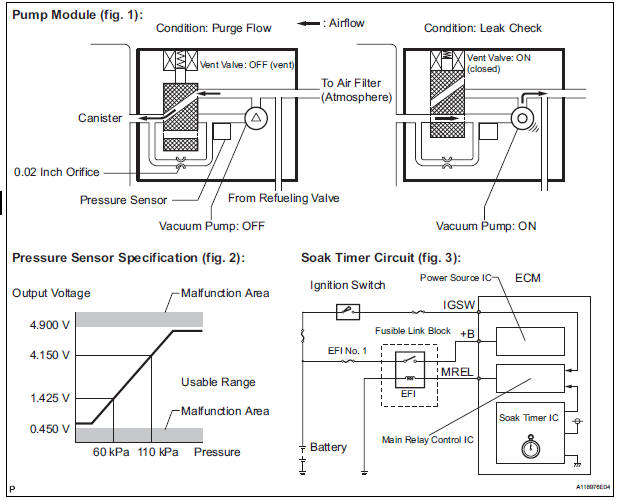
WIRING DIAGRAM
Refer to DTC P0450.
INSPECTION PROCEDURE
NOTICE: An intelligent tester is required to conduct the following diagnostic troubleshooting procedure.
HINT:
- Using intelligent tester monitor results enables the EVAP (Evaporative Emission) system to be confirmed.
- Read freeze frame data using the intelligent tester. The ECM records vehicle and driving condition information as freeze frame data the moment a DTC is stored. When troubleshooting, freeze frame data can be helpful in determining whether the vehicle was running or stopped, whether the engine was warmed up or not, whether the air-fuel ratio was lean or rich, as well as other data recorded at the time of a malfunction.
1 CONFIRM DTC
- Turn the ignition switch off and wait for 10 seconds.
- Turn the ignition switch to the ON position.
- Turn the ignition switch off and wait for 10 seconds.
- Connect the intelligent tester to the DLC3.
- Turn the ignition switch to the ON position and turn the tester on.
- Select the following menus: DIAGNOSIS / ENHANCED OBD II / DTC INFO / CURRENT CODES.
- Confirm DTCs and freeze frame data.
If any EVAP system DTCs are set, the malfunctioning area can be determined using the table below.
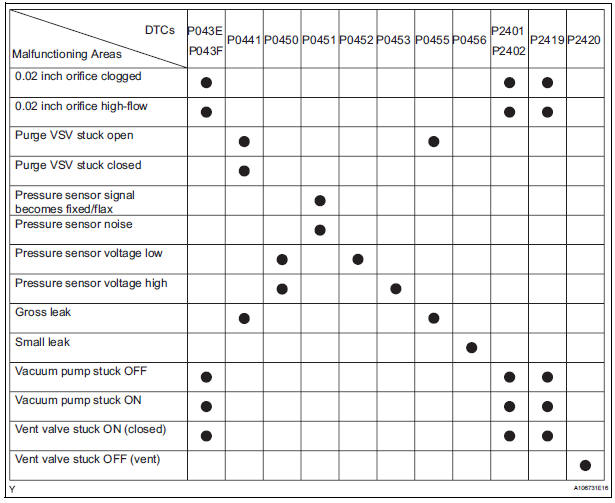
NOTICE: If the 0.02 inch reference pressure difference between the first and second checks is greater than the specification, the DTCs corresponding to the reference pressure (P043E, P043F, P0441, P0455, P0456, P2401 and P2420) will all be stored.
2 PERFORM EVAP SYSTEM CHECK (AUTO OPERATION)
NOTICE:
- In the EVAP SYSTEM CHECK (AUTO OPERATION), the series of 5 EVAP SYSTEM CHECK steps is performed automatically by the intelligent tester. It takes a maximum of approximately 18 minutes.
- Do not perform the EVAP SYSTEM CHECK when the fuel tank is more than 90% full because the cut-off valve may be closed, making the leak check of the fuel tank unavailable.
- Do not run the engine in this step.
- When the temperature of the fuel is 35C (95F) or more, a large amount of vapor forms and any check results become inaccurate. When performing the EVAP SYSTEM CHECK, keep the temperature below 35C (95F).
- Connect the intelligent tester to the DLC3.
- Clear the DTCs.
- Select the following menu items on the tester: DIAGNOSIS / ENHANCED OBD II / SYSTEM CHECK / EVAP SYS CHECK / AUTO OPERATION.
- After the EVAP SYSTEM CHECK is completed, check for pending DTCs by selecting the following menu items: DIAGNOSIS / ENHANCED OBD II / DTC INFO / PENDING CODES.
HINT: If no pending DTC is displayed, perform the Monitor Confirmation after this repair is completed. After this confirmation, check for pending DTCs. If no DTC is displayed, the EVAP system is normal.
3 PERFORM EVAP SYSTEM CHECK (MANUAL OPERATION)
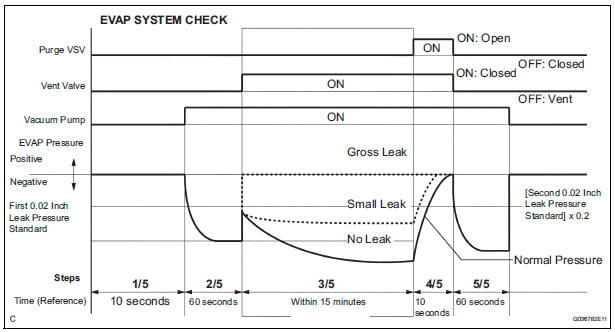
NOTICE:
- In the EVAP SYSTEM CHECK (MANUAL OPERATION), the series of 5 EVAP SYSTEM CHECK steps is performed manually by the intelligent tester.
- Do not perform the EVAP SYSTEM CHECK when the fuel tank is more than 90% full because the cut-off valve may be closed, making the leak check of the fuel tank unavailable.
- Do not run the engine in this step.
- When the temperature of the fuel is 35C (95F) or more, a large amount of vapor forms and any check results become inaccurate. When performing the EVAP SYSTEM CHECK, keep the temperature below 35C (95F).
- Connect the intelligent tester to the DLC3.
- Clear the DTCs.
- Select the following menu items: DIAGNOSIS / ENHANCED OBD II / SYSTEM CHECK / EVAP SYS CHECK / MANUAL OPERATION.
4 PERFORM EVAP SYSTEM CHECK (STEP 1/5)
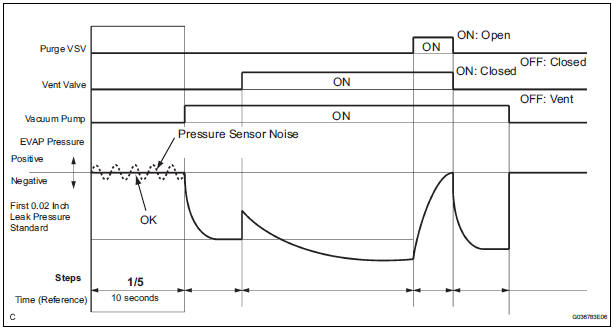
- Check the EVAP pressure in step 1/5.
Result

*: The DTCs relating to the EVAP system displayed on the intelligent tester when checking.
5 PERFORM EVAP SYSTEM CHECK (STEP 1/5 TO 2/5)
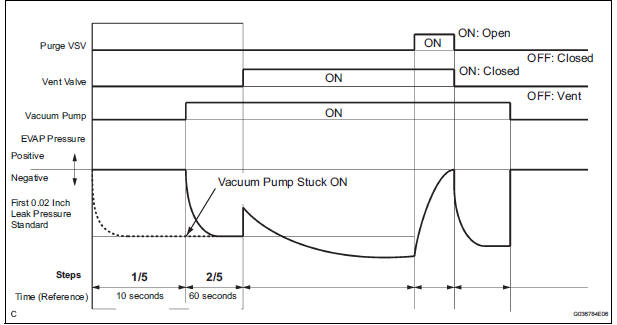
- Check the EVAP pressure in steps 1/5 and 2/5
Result

*: The DTCs related to the EVAP system are displayed on the intelligent tester when checking.
HINT: The first 0.02 inch leak pressure standard is the value determined in step 2/5.
6 PERFORM EVAP SYSTEM CHECK (STEP 2/5)
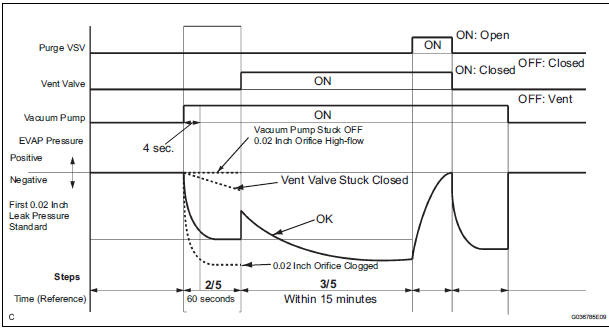
HINT: Make a note of the pressures checked in steps (a) and (b) below.
- Check the EVAP pressure 4 seconds after the vacuum pump is activated*1 (Step (a)).
- Check the EVAP pressure again when it has stabilized.
This pressure is the 0.02 inch leak pressure standard (Step (b)).
*1: The vacuum pump begins to operate at the time step 2/5 starts.
Result

*2: The DTCs related to the EVAP system are displayed on the intelligent tester when checking.
7 PERFORM EVAP SYSTEM CHECK (STEP 2/5 TO 3/5)
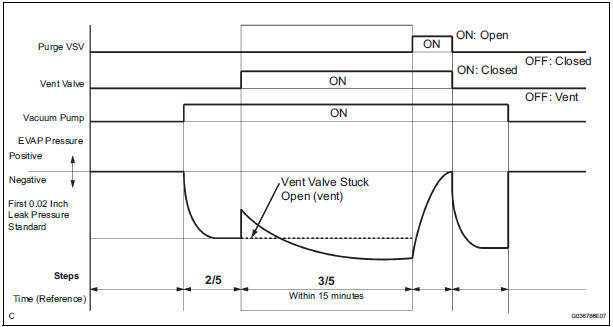
- Check the EVAP pressure increase in step 3/5
Result

*: The DTCs related to the EVAP system are displayed on the intelligent tester when checking.
8 PERFORM EVAP SYSTEM CHECK (STEP 3/5)
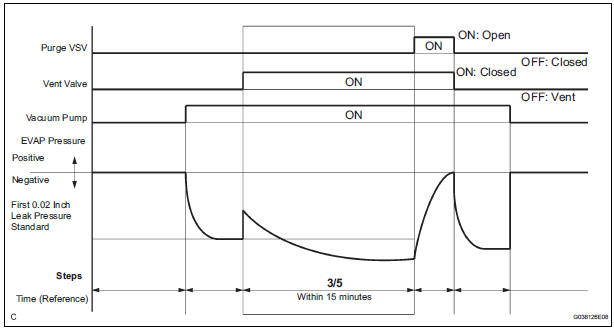
- Wait until the EVAP pressure change is less than 0.1 kPa (0.75 mmHg) for 30 seconds.
- Measure the EVAP pressure and record it.
HINT: A few minutes are required for the EVAP pressure to become saturated. When there is little fuel in the fuel tank, it takes up to 15 minutes.
9 PERFORM EVAP SYSTEM CHECK (STEP 4/5)
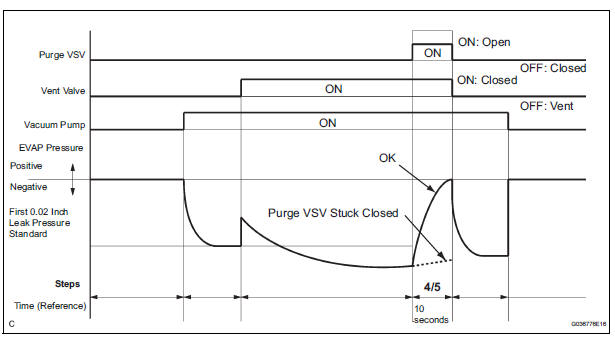
- Check the EVAP pressure in step 4/5.
Result

*: The DTCs related to the EVAP system are displayed on the intelligent tester when checking.
10 PERFORM EVAP SYSTEM CHECK (STEP 5/5)
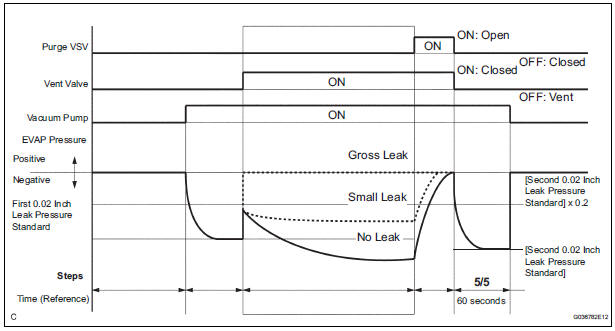
- Check the EVAP pressure in step 5/5.
- Compare the EVAP pressure in step 3/5 and the second 0.02 inch leak pressure standard (step 5/5).
Result

*: The DTCs related to the EVAP system are displayed on the intelligent tester when checking.
11 PERFORM EVAP SYSTEM CHECK (STEP 3/5)
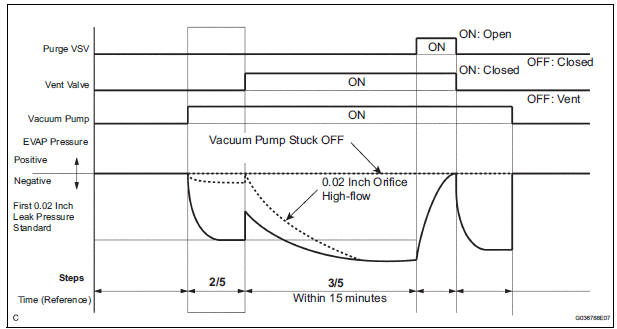
- Check the EVAP pressure in step 3/5.
Result

*: The DTCs related to the EVAP system are displayed on the intelligent tester when checking.
HINT: The first 0.02 inch leak pressure standard is the value determined in step 2/5.
12 PERFORM ACTIVE TEST BY INTELLIGENT TESTER (PURGE VSV)
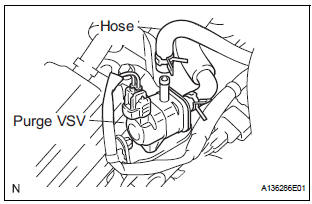
- Select the following menu items on the tester: DIAGNOSIS / ENHANCED OBD II / ACTIVE TEST / EVAP VSV (ALONE).
- Disconnect the hose (connected to the canister) from the purge VSV.
- Start the engine.
- Using the tester, turn off the purge VSV (EVAP VSV: OFF).
- Confirm that the purge VSV has no suction with your fingers.
- Using the tester, turn on the purge VSV (EVAP VSV: ON).
- Confirm that the purge VSV has suction with your fingers.
Result
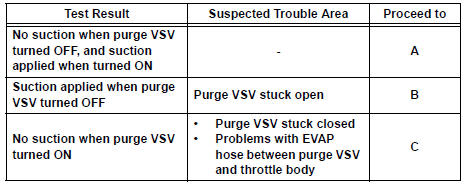
- Reconnect the hose.
13 CHECK FUEL TANK CAP ASSEMBLY
- Check that the fuel tank cap is correctly installed and confirm the fuel tank cap meets OEM specification.
HINT: If an EVAP tester is available, check the fuel tank cap using the tester.
- Tighten the fuel tank cap
- Remove the fuel tank cap and install it onto the fuel tank cap adaptor.
- Connect the EVAP tester pump hose to the adaptor, and pressurize the cap to 3.2 to 3.7 kPa (24 to 28 mmHg) using an EVAP tester pump.
- Seal the adaptor and wait for 2 minutes.
- Check the pressure. If the pressure is 2 kPa (15 mmHg) or more, the fuel tank cap is normal.
Result

14 INSPECT PURGE VSV
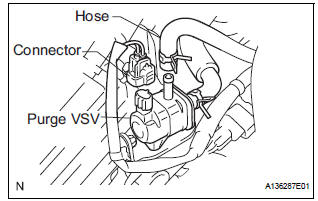
- Turn the ignition switch off.
- Disconnect the V3 purge VSV connector.
- Disconnect the hose (connected to the canister) from the purge VSV.
- Start the engine.
- Confirm that the purge VSV has no suction with your fingers.
Result

- Reconnect the purge VSV connector.
- Reconnect the hose.
15 CHECK EVAP HOSE (PURGE VSV - THROTTLE BODY)
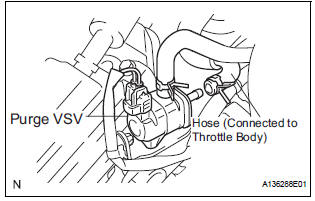
- Disconnect the hose (connected to the throttle body) from the purge VSV.
- Start the engine.
- Confirm that the hose has suction with your fingers.
Result

- Reconnect the hose.
16 INSPECT VACUUM SWITCHING VALVE NO. 1 (PURGE VSV)
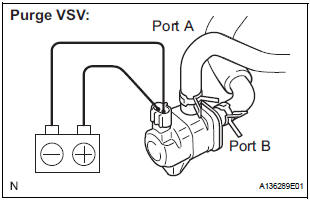
- Remove the purge VSV.
- Apply battery voltage to the terminals of the purge VSV.
- Using compressed air, confirm that air flows from port A to port B.
Result

- Install the purge VSV.
17 CHECK HARNESS AND CONNECTOR (POWER SOURCE OF PURGE VSV)
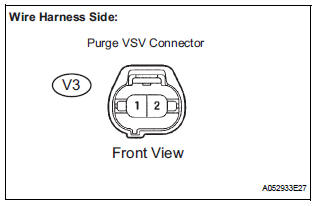
- Disconnect the V3 purge VSV connector.
- Turn the ignition switch to the ON position.
- Measure the voltage between terminal 1 of the purge VSV connector and body ground.
Result

- Reconnect the purge VSV connector.
18 CHECK HARNESS AND CONNECTOR (PURGE VSV - ECM)
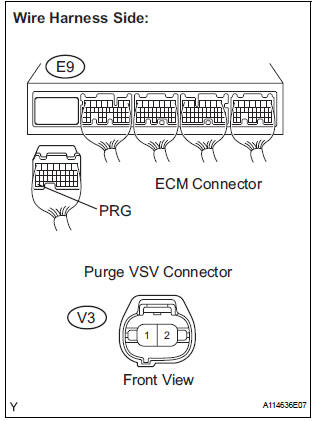
- Disconnect the E9 ECM connector and the V3 purge VSV connector.
- Measure the resistance between the terminals of the purge VSV connector and ECM connector.
Standard resistance

- Reconnect the purge VSV connector.
- Reconnect the ECM connector.
19 PERFORM ACTIVE TEST BY INTELLIGENT TESTER (FOR VENT VALVE)
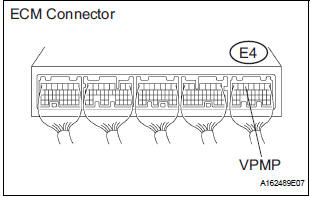
- Turn the ignition switch to the ON position.
- Select the following menu items on the tester: DIAGNOSIS / ENHANCED OBD II / ACTIVE TEST / VENT VALVE.
- Measure the voltage between terminal VPMP of the ECM connector and body ground when the vent valve is turned ON (close) and OFF (vent) using the tester.
Result

20 PERFORM ACTIVE TEST BY INTELLIGENT TESTER (FOR VENT VALVE)
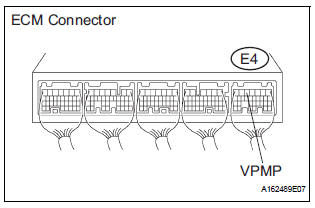
- Turn the ignition switch to the ON position.
- Select the following menu items on the tester: DIAGNOSIS / ENHANCED OBD II / ACTIVE TEST / VENT VALVE (ALONE).
- Measure the voltage between terminal VPMP of the ECM connector and body ground when the vent valve is turned ON (close) and OFF (vent) using the tester.
Result

21 INSPECT PUMP MODULE (POWER SOURCE FOR VENT VALVE)
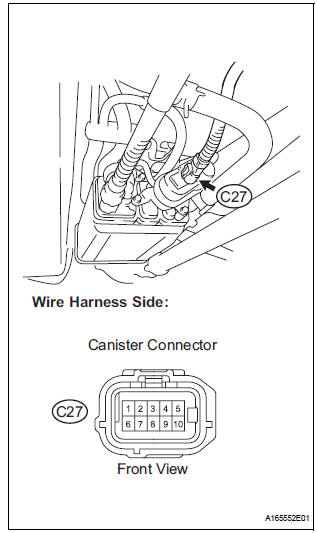
- Turn the ignition switch off.
- Disconnect the C27 canister connector.
- Turn the ignition switch to the ON position.
- Measure the voltage between terminal 9 of the canister connector and body ground.
Result

- Reconnect the canister connector.
22 INSPECT PUMP MODULE (VENT VALVE OPERATION)
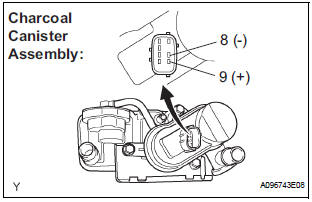
- Turn the ignition switch off.
- Disconnect the C27 canister connector.
- Apply the battery voltage to terminals 9 and 8 of the pump module.
- Touch the pump module to confirm the vent valve operation.
Result

- Reconnect the canister connector
23 PERFORM ACTIVE TEST BY INTELLIGENT TESTER (FOR PUMP MODULE (VACUUM PUMP))
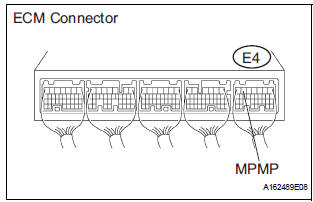
- Select the following menu items on the tester: DIAGNOSIS / ENHANCED OBD II / ACTIVE TEST / VACUUM PUMP.
- Measure the voltage between terminal MPMP of the
ECM connector and body ground when the vacuum
pump is turned ON and OFF using the tester.
Result
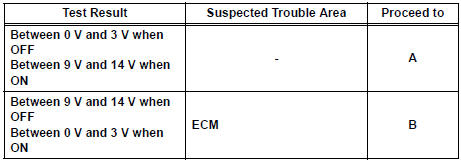
24 CHECK HARNESS AND CONNECTOR (PUMP MODULE - ECM)
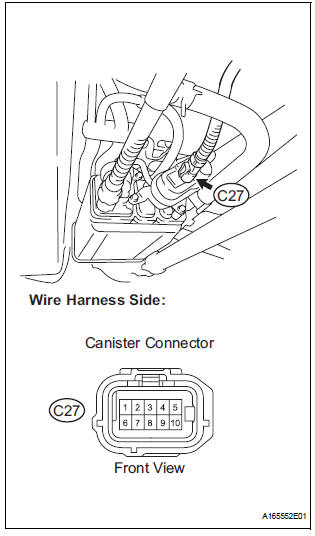
- Turn the ignition switch off.
- Disconnect the C27 canister connector.
- Turn the ignition switch to the ON position.
- Select the following menu items on the tester: DIAGNOSIS / ENHANCED OBD II / ACTIVE TEST / VACUUM PUMP.
- Turn the vacuum pump ON.
- Measure the voltage between terminal 1 of the canister connector and body ground.
Result

- Reconnect the canister connector.
25 CHECK HARNESS AND CONNECTOR (PUMP MODULE - BODY GROUND)
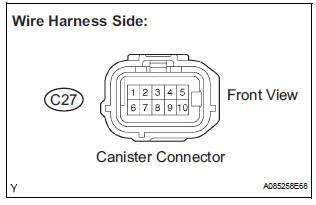
- Disconnect the C27 canister connector.
- Turn the ignition switch off.
- Check the resistance between terminal 6 of the canister connector and body ground.
Result

- Reconnect the canister connector.
26 INSPECT THROTTLE BODY
- Stop the engine.
- Disconnect the EVAP hose from the throttle body.
- Start the engine.
- Confirm that the port of he throttle body has suction with your fingers.
Result

- Reconnect the EVAP hose.
27 CORRECTLY REINSTALL OR REPLACE FUEL TANK CAP
HINT:
- When reinstalling the fuel tank cap, tighten it until a few click sounds are heard.
- When replacing the fuel tank cap, use a fuel tank cap that meets OEM specifications, and tighten it until a few click sounds are heard.
28 REPLACE FUEL TANK CAP ASSEMBLY
HINT: When installing the fuel tank cap, tighten it until a few click sounds are heard.
29 LOCATE EVAP LEAK
- Disconnect the vent hose.
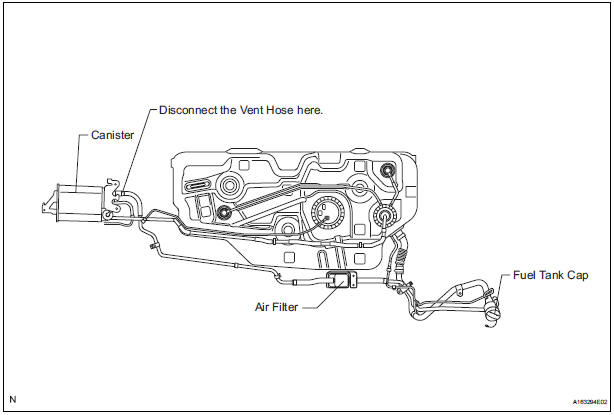
- Connect the EVAP pressure tester tool to the canister with the adapter.
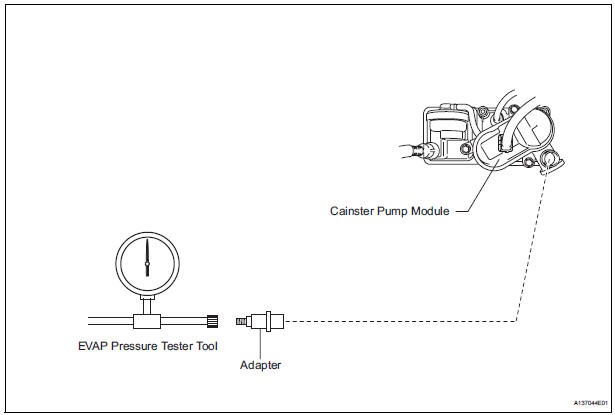
- Pressurize the EVAP system by 3.2 to 3.7 kPa (24 to 28 mmHg).
- Apply soapy water to the piping and the connecting parts of the EVAP system.
- Look for areas where bubbles appear. This indicates a leak point.
- Repair or replace the leak point.
30 REPLACE CHARCOAL CANISTER ASSEMBLY
- Replace the charcoal canister assembly.
NOTICE: When replacing the canister, check the canister pump module interior and related pipes for water, fuel and other liquids. If liquids are present, check for disconnections and/or cracks in the following: 1) the pipe from the air inlet port to the canister pump module; 2) the canister filter; 3) the fuel tank vent hose.
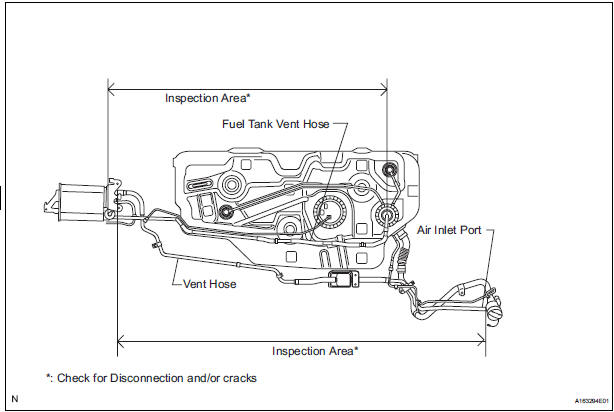
31 REPLACE VACUUM SWITCHING VALVE NO. 1 (PURGE VSV)
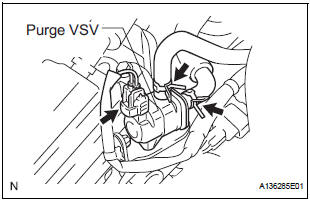
- Disconnect the connector and 2 hoses from the purge VSV.
- Remove the purge VSV.
- Install a new purge VSV.
- Reconnect the connector and 2 hoses.
32 REPAIR OR REPLACE HARNESS OR CONNECTOR
33 REPLACE EVAP HOSE (THROTTLE BODY - PURGE VSV)
34 INSPECT THROTTLE BODY
- Remove the throttle body.
- Check that the EVAP purge port of the throttle body is not clogged. If necessary, replace the throttle body.
35 REPLACE ECM
- Replace the ECM
36 REPAIR OR REPLACE PARTS AND COMPONENTS INDICATED BY OUTPUT DTCS
- Repair the malfunctioning areas indicated by the DTCs that had been confirmed when the vehicle was brought in.
37 PERFORM EVAP SYSTEM CHECK (AUTO OPERATION)
NOTICE:
- In the EVAP SYSTEM CHECK (AUTO OPERATION), the series of 5 EVAP SYSTEM CHECK steps are performed automatically. It takes a maximum of approximately 18 minutes.
- Do not perform the EVAP SYSTEM CHECK when the fuel tank is more than 90% full because the cut-off valve may be closed, making the leak check of the fuel tank unavailable.
- Do not run the engine in this step.
- When the temperature of the fuel is 35C (95F) or more, a large amount of vapor forms and any check results become inaccurate. When performing an EVAP SYSTEM CHECK, keep the temperature below 35C (95F).
- Clear the DTCs.
- On the intelligent tester, select the following menu items: DIAGNOSIS / ENHANCED OBD II / SYSTEM CHECK / EVAP SYS CHECK / AUTO OPERATION.
- After the SYSTEM CHECK is completed, check for pending DTCs by selecting the following menu items: DIAGNOSIS / ENHANCED OBD II / DTC INFO / PENDING CODES.
HINT: If no pending DTC is found, the repair has been successfully completed.
COMPLETED
 Active Control Engine Mount System
Active Control Engine Mount System
DESCRIPTION
LOCATION
The Active Control Engine Mount (ACM) system decreases engine vibration at
engine idling using the
ACM VSV. The VSV is controlled by a pulse signal transmitted to the VSV ...
 ECM Power Source Circuit
ECM Power Source Circuit
DESCRIPTION
When the ignition switch is turned to the ON position, the battery voltage is
applied to terminal IGSW of
the ECM. The ECM MREL output signal causes a current to flow to the coil,
cl ...
Other materials:
Removal
1. REMOVE FRONT WIPER ARM HEAD CAP
Using a small screwdriver, remove the 2 front wiper
arm covers.
HINT:
Tape up the screwdriver tip before use.
2. REMOVE FR WIPER ARM RH
Operate the wiper, and stop the windshield wiper
motor assembly to the automatic stop position.
...
Center Airbag Sensor Assembly Communication
Circuit Malfunction
DTC B1790 Center Airbag Sensor Assembly Communication
Circuit Malfunction
DESCRIPTION
The center airbag sensor assembly communication circuit consists of the
occupant classification ECU and
the center airbag sensor assembly.
DTC B1790 is recorded when a malfunction is detected in the center ...
ABS Warning Light does not Come ON
WIRING DIAGRAM
See page BC-47.
INSPECTION PROCEDURE
1 INSPECT ABS WARNING LIGHT
(a) Disconnect the skid control ECU connector.
(b) Turn the ignition switch to the ON position.
(c) Check that the ABS warning light comes on.
OK:
ABS warning light comes on.
HINT:
If troubleshooting has be ...
